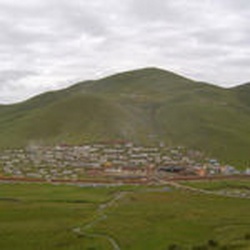Tridé Songtsen
Sadnalegs or Tridé Songtsen (Wylie: Khri-lde-srong-btsan), was the youngest son of King Trisong Detsen of Tibet (reigned c. 800–815 CE – though various accounts give the beginning of his reign as 797 or 804 CE).
Trisong Detsen retired to live at Zungkar and handed power to his second son, Mune Tsenpo, in 797. From this point there is much confusion in the various historical sources. It seems there was a struggle for the succession after the death of Trisong Detsen. It is not clear when Trisong Detsen died, or for how long Mune Tsenpo reigned. It is said that Mune Tsenpo was poisoned by his mother who was jealous of his beautiful wife.
Whatever the case, both the Tang Annals and the Tibetan sources agree that, since Mune Tsenpo had no heirs, power passed to his younger brother, Sadnalegs, who was on the throne by 804 CE.
The other brother, Mutik Tsenpo, was apparently not considered for office as he had previously murdered a senior minister and had been banished to Lhodak Kharchu near the Bhutanese border.
As he was quite young when he came to the throne, Sadnalegs was assisted by four experienced ministers, two of whom were also Buddhist monks. They followed the policies of the previous kings. Sadnalegs had four wives from different Tibetan clans.
Support for Buddhism
Indian scholars were invited to Samye Monastery to help translate Buddhist texts. Sadnaleg had the temple of Skar-cung (Karchung) built near Lhasa. Due to opposition to Buddhism, the king called a meeting with delegates and vassals from all over the kingdom and drew up a document pledging support for Buddhism which was signed by all who attended. An inscribed pillar with an account of this pledge was erected in front of the Karchung which still exists and has been translated into English.
Political and military activities
Although Tibetan forces were fighting the Chinese between 799 and 803, with battles in Yanzhou, Linzhou, Weizhou, Yazhou and Suizhou, envoys began travelling regularly from 804 onwards between Lhasa and China, although no formal treaty was signed. When Emperor De Zong died in 805, Ralpacan sent gifts of gold, silver, cloth, oxen and horses for the funeral.
The Tibetan army continued to attack the Arabs to the west and, according to al-Ya'qubi, they besieged Samarkand, the capital of Transoxiana at the time. Finally, the Tibetan Governor of Turkestan presented a statue made of gold and precious stones to the Arab Caliph al-Ma'mun (r. 813–833). This statue was later sent to the Ka'ba in Mecca.
Death and succession
Sadnalegs probably died in 815 (though the Blue Annals give 814). He had five sons, the first became a monk, the last two died in childhood. When Sadnaleg died, Langdarma was bypassed as he was anti-Buddhist and hot tempered and the royal power was given to Ralpacan.
An impressive stone pillar with an inscription commemorating Sadnalegs stand in the burial ground of the Tibetan kings near 'Phyong-rgas. It is partially illegible but confirms a number of historical events. It is of importance in dating Sadnalegs' reign as it states that warfare with China began when he took power. The Tang Annals report that the Chinese and Tibetans were fighting continuously between 799 and 803 CE, so it seems likely that Sadnalegs came to the throne c. 800–804 CE.

